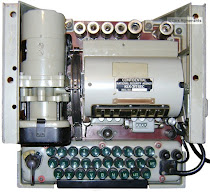 |
| TSEC/KL-7 © Dirk Rijmenants |
The TSEC/KL-7 was the first rotor cipher machine to use electronics, and although the KL-7 had excellent cryptographic properties, its track record is what made this machine a true Cold War icon. My first encounter with that curious unknown machine with vacuum tubes was back in 2005 in London on the battleship HMS Belfast, displayed behind glass.
It took another six years to unravel the inner workings of this cryptologic beauty, and write the first accurate KL-7 simulator. This was only possible thanks to the release of many technical documents from the National Security Agency (NSA), through Freedom of Information Act requests (FOIA's) from Bill Neill, and published by Nick England from US Navy Radio Communications. The technical expertise from Paul Reuvers and Marc Simons from the Crypto Museum, and from George Mace, were also instrumental to develop the KL-7 simulator.
However, despite the release of some history related documents, only fragmented pieces of its development and operational use were available, and the history of the KL-7, initially named AFSAM-7, remained largely unknown to the public. In the last three years, I could connect more dots, found in the NSA's William Friedman records.
Historical records from the U.S. Army Security Agency (ASA) contained production details, planning and procurement, and later described the analysis
of the KL-7's use in Vietnam. Those records were preserved by the NSA. The NATO archives revealed the use of the KL-7 by many allied countries and some of their state departments, and the technical support they received.
Although there were only unconfirmed hints that the KL-7 was also used by the CIA and FBI, some tiny bits of information provided clues on where and how to search for more information. Moreover, ASA records confirmed the procurement for those agencies. That search took long, but eventually led to a few CIA documents, multiple FBI files, and letters from FBI director J. Edgar Hoover that confirmed their own use of the KL-7, and its use by the White House, on the presidential airplane Air Force One, and several Asian countries.
The KL-7 also has its own chapters in the history of Cold War espionage, with chief warrant officer John Walker selling the machine's technical details and secret keys lists to the Soviets, but the Counter Intelligence records from the Director of National Intelligence (DNI) also detailed warrant officer Joseph Helmich's betrayal, leading to other FBI files on counterintelligence operation Hookshot to catch Helmich. His case is less known than John Walker's, but just as interesting.
Ever more pieces of information were added to the KL-7 webpage, which already contained all technical information, making it quite large. To make the KL-7 history more accessible, I decided to publish the article that I started in 2022, which also includes references to the relevant ASA, AFSA, NSA, NATO, FBI, CIA and DNI files. This way, everyone can easily find all related files for their own research.
Since my motto is "history is here to share", you're free to share or publish the
below document, or parts of it, provided that proper credits are added. Why should you share it? Because its use across the world for decades, and the spy cases, make the KL-7 a true Cold War icon that deserves its place in history, but also to honor the cryptologists and engineers who developed this marvel, and the operators who served around the world, lest we forget.
History of the TSEC/KL-7 ADONIS & POLLUX - The first standard U.S. tactical lightweight rotor cipher machine using electronics (pdf)
(latest update November 11, 2025 Version 5.3)
If you're also interested in how the machine works, its development and full history, then visit the TSEC/KL-7 page at the website.
Call to Veterans! If you operated or maintained the KL-7, we're always interested in your experiences with the machine to expand its history. We're not interested in classified information, only stories about where and how you worked with the KL-7 (the machine is declassified). Since the KL-7 retired more than 40 years ago, time is running out to document stories. If you have a story to share, then contact us through the contact page on our website Cipher Machines and Cryptology.
Let's preserve cryptologic history!
To get an idea of the kind of stories we would like to document, check out these already published stories, also available at the website:
- KL-7 in Vietnam - COMSEC Support at Air Base Saigon
- OTT Mixers and the KL-7 at NATO in West Germany
- The KL-7 on Merchant Ships during the Falklands War
Enjoy reading!
2 comments:
The KL-7 was the valuable means of exchanging highly classified (Top Secret/Codeword) information between military facilities and with the National Security Agency (NSA). In my personal experience as a Communications Technician – later changed to”Cryptologic Technician” (Operations Branch) working in Naval Security Group (NSG) communication centers– this was “our” mainstay for communications security protecting intelligence information.
"Initially named AFSAM-7, the KL-7 was developed for all US armed forces, but the US Navy developed its own fully compatible version with a few more options, named AFSAM-47, later designated KL-47.”
See: file:///C:/Users/maack/Documents/NAVY%20CAREER.pdf
Dear Charles, linking documents from your computer doesn't work.
If you have more info to share on the KL-47, you can always e-mail us through the website. The PCM, later renamed AFSAM-47 and KL-47, was developed in parallel with the KL-7, but used the BRUTUS crypto principle and a different uppercase system. The eventually made the 47 fully compatible with the KL-7. However, info on the KL-47 is sparse. If you have additional information, you can e-mail/contact us through the website. We're always happy to share your story, and help to compile it (unclassified info only)
https://www.ciphermachinesandcryptology.com
Here's an example we published: https://www.ciphermachinesandcryptology.com/papers/KL-7_on_Merchant_Ships_During_Falklands_War.pdf
Post a Comment